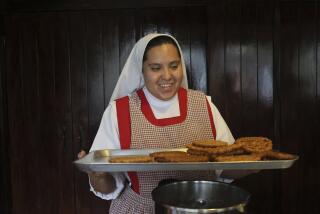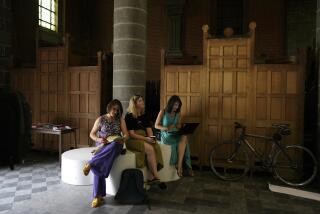How <i> Beguines</i> Lived in the Beginning
- Share via
AMSTERDAM — In the 12th Century, a wealthy Flemish priest named Lambert le Begue established a community in Liege for widows of crusaders.
Called beguines, the women lived in a walled district referred to as a beguinage. They followed no rule except to do good works.
A century later, one could find beguinages in nearly every town in Flanders, which included parts of the modern-day Netherlands, Belgium and France.
Time stopped at the end of the Middle Ages for the beguinages. Scores of them survive in the Netherlands and Belgium as medieval enclaves in modern cities, offering a rare glimpse into the life of another age.
Originally, women of all classes gained admission to the beguinages. Wealthy beguines took retinues of servants, but also subsidized poor beguines.
The beguine devoted herself to practical works of charity by manual labor, teaching the children of burghers and caring for the sick.
Beguines took no religious vows and always remained free to return to the world with their property.
Some beguinages evolved into houses of religious orders, semi-convents occupying a position midway between monastic and lay status.
Only a short walk from busy shopping streets, the beguinages now look much as they did 800 years ago: miniature houses and larger buildings grouped around a courtyard and walled off from the modern world.
The beguine community contains a guest house, a church, an infirmary and the home of the head mistress. Frequent government subsidies ensure a firm financial foundation.
In the Netherlands, where the Dutch refer to beguinages as begijnhofs or hofjes, the begijnhof in the heart of Amsterdam has been home to many since the 14th Century.
It’s a block from Kalverstraat, the most crowded shopping street in the country. The begijnhof was rebuilt at city expense during the 17th and 18th centuries.
Members of the Amsterdam begijnhof are elderly, widowed women or single Catholic women of scant means. They pay a nominal fee to remain residents.
Holland’s other begijnhofs, also publicly financed, provide housing for about 4,000 elderly women.
Although now a pastoral oasis, the begijnhof in Amsterdam acted as a religious battleground during the Reformation. After becoming Protestant, Holland converted the Roman Catholic church to a Protestant English Reformed church.
A stained-glass window in that church depicts the departure in 1620 of John Robinson’s separatists to Plymouth, where his followers joined other pilgrims intent on establishing a settlement in the New World.
Fifty years later, Catholics built a clandestine church in the begijnhof, but not before a lay sister named Cornelitgen Arents chose burial in a gutter rather than in the church that was no longer hers.
The gravestone in the gutter might be pointed out to a visitor by a resident such as Lena Maria Zeldenthuis, who has lived in the begijnhof for 25 years.
Auntie Helen, as she is called, might mention that no other begijnhof contains both a Catholic and a Protestant church, for Holland’s other begijnhofs are either non-religious or wholly Protestant.
She might reveal that only women joined the begijnhof because men would be unable to perform adequately the many household chores and would represent an added expense to benefactors. She might also tell of writing to American tourists who visit the begijnhof in the spring to admire the cherry blossoms.
“It’s impossible to feel lonely here,” Auntie Helen said, “and what is very important to me is that I am living in a community, but still have my independence.”
Unlike Holland’s begijnhofs, the beguinages in Belgium usually have a religious affiliation. In the medieval city of Bruges the beguinage houses Benedictine nuns, not beguines. Built in the middle of the 13th Century, the beguinage is a major tourist attraction.
One enters by a bridge over a canal--the Flemish name of the city, Brugge, means bridge. “Le grande dame,” who lives near the main gate, will grant permission for house tours.
In the 14th Century, the nuns of the beguinage rescued a vial said to contain a drop of Christ’s blood from the Crucifixion. Brought back from the Second Crusade by Dierick of Alsace, the relic was tossed into the water for safety near the beguinage when Gent invaded Bruges during one of the many wars between the two cities.
The relic remains on display every Friday throughout the year in the chapel known as the Basilica of the Holy Blood.
In Gent, the historic capital of Flanders, beguines and nuns live and work together in three beguinages. Beguines in Belgium wear the old Flemish headdress and dark costume, so it is difficult to distinguish beguines from nuns.
Gent’s oldest and largest beguinage , St. Elisabeth’s, is home to 1,000 residents. A high wall isolates it as a preserve of peace and quiet in a modern industrial city.
The city’s other beguinages, the Klein and the Groot, are short streetcar rides from the center of the city.
The most notable beguinage in Belgium is in nearby Leuven, near Brussels. The wide lawns, narrow cobblestone streets and lacework of canals in the walled community have recently been given to the University of Leuven as a home for married students.
Historically, beguinages prided themselves on diverse development, and the Leuven beguinage continues that flexible, albeit secular, tradition.
Only groups of students’ bicycles leaning here and there against stone walls give away the changed character of the beguinage’s history.
Rather than anachronisms, today’s beguinages in Belgium and the Netherlands possess a medieval presence that makes the surrounding modern world seem askew and out of date. A beguinage does more than transport a visitor to a peaceful, captivating past. It conveys heritage.
The spirit of life in a beguinage can be captured in the word deftigheid, which to Amsterdammers sums up the virtues of decorum, propriety and dignity--the legacy bequeathed by Lambert le Begue.
More to Read
Sign up for Essential California
The most important California stories and recommendations in your inbox every morning.
You may occasionally receive promotional content from the Los Angeles Times.













